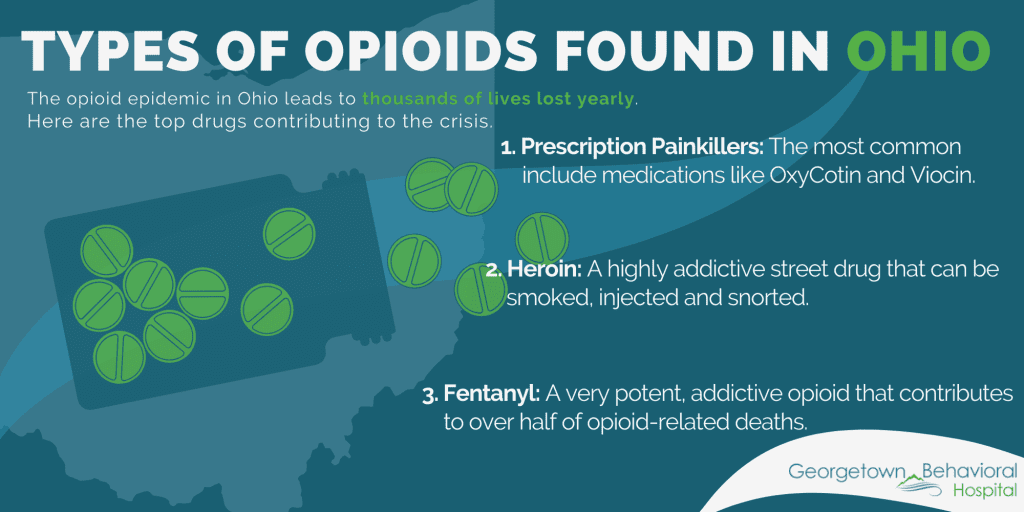Ohio is one of the most affected states by the opioid epidemic, with some of the top numbers of opioid-related deaths in the nation. Here is what you should know about the state of opioid addiction in Ohio and where to seek treatment if you or a loved one have an addiction.
Georgetown Behavioral Hospital can help you take the first steps towards sobriety. Contact us today to learn more.
Ohio sits at the center of a firestorm of opioid abuse and overdose. Despite a brief decrease in 2017, the death rate linked to opioid-related overdose continues to spiral out of control. Data from 2017 shows the opioid epidemic costs Ohio up to $8.8 billion a year. Understanding exactly what the below statistics mean for Ohio residents first requires learning more about opioid drugs.
What Are Opioids?

Opioids are a class of drugs responsible for causing various calming and sedating effects on the brain. They are believed to block pain signals from being received by the brain when sent from different areas in the body. Opioids can either be prescription medications (generally known as painkillers) or street drugs such as Heroin.
In addition to blocking pain signals sent from the body, opioid drugs can also cause feelings of intense relaxation and a “high” that inhibits the feeling of certain (unpleasant) emotions. Unfortunately, opioid users quickly develop a tolerance to and a physical dependence on opioids, which makes them highly addictive. The most commonly abused opioids are prescription medications, including OxyContin and Vicodin, and street drugs like Heroin and fentanyl.
Painkillers (Prescription Pain Medications)
As previously noted, prescription opioids (painkillers) are prescribed to treat moderate to severe pain conditions. In recent years, there has been a dramatic increase in opioid prescribing, which has caused an equally significant increase in illicit substance use. Prescription opioids are incredibly addictive. Studies show that one in four people using opioid therapy long-term has an opioid addiction. In 2018, just under 47,000 Americans died from an opioid overdose. Of those, 32% involved prescription opioids obtained with legal prescriptions.
Heroin
As the state and local organizations work with the medical community works to reduce the number of opioid prescriptions, people with opioid addictions must seek a replacement substance to satisfy drug cravings. Heroin produces similar effects on the body to prescription opioids.
Due to the shift in prescribing rates and subsequent drug-seeking behaviors, heroin use has increased dramatically nationwide in recent years. Heroin is a highly addictive drug that comes in several forms and can be smoked, injected, and snorted. Since 2000, more than 115,000 Americans have died from overdoses related to Heroin.
Fentanyl
Fentanyl is a highly addictive drug because of its potency. Fentanyl is dramatically more potent and more dangerous than opioids in the same drug class. This significantly contributes to its overdose potential.
When fentanyl attaches to the body’s opioid receptors, it does so in such a way that it can sometimes overpower life-sustaining systems, including the brain and respiratory systems. This effect can quickly lead to an overdose. The speed at which someone feels the results of fentanyl mean the user may not be able to recover in time to stop or seek help for the effects of an overdose.
Data from the Centers for Disease Control and Prevention (CDC) show that 67% of opioid-related deaths in 2021 were due to synthetic drugs like fentanyl.
Opioids in Ohio
In 2017, the state of Ohio proudly reported the rate of prescription drug overdose death had declined by twenty-eight percent, reaching an eight-year low. In 2017, prescription drug overdose accounted for just 523 of the state’s approximately 4,900 accidental overdose deaths. The most affected individuals were predominately males ages twenty-five to forty-four.
Unfortunately, the decline in overdose deaths reported in 2017 was not meant to last. By the end of 2019, the number had increased to 38.3 overdose deaths per 100,000 residents. This indicates an increase of over 6% from 2017 and 7% from 2018. In 2019, illicit drugs such as fentanyl remained the most often associated with accidental overdose. However, deaths from psychostimulant drugs surpassed the overdose death rate from Heroin.
Data from reports released in 2021 shows that opioid deaths increased by 25% over 2019, with over 5,000 opioid-related fatalities. In the year 2020:
- The rate of unintentional overdose death for non-Hispanic African Americans (55.2 per 100,000) surpassed the rate of white non-Hispanics (46.8 per 100,000).
- African-American non-Hispanic males had the highest rate of death due to overdose in the state of Ohio. This demographic ranked higher than all other ethnicities/sex/race groups.
- The opioid fentanyl was involved in 81% of overdose deaths in Ohio in 2020, an increase from 76% in 2019 and 71% in 2017.
- Fentanyl was also linked to 83% of all heroin-related overdose deaths, 80% of all cocaine-related overdose deaths, and 79% of all overdose deaths involving methamphetamines or other psychostimulant drugs.
- In 2020, the hardest hit counties in Ohio were Scioto, with 35.22 out of 100,000 deaths involving opioids), Fayette (20.67 out of 100,000), and Franklin (19.43 per 100,000).
Seeking Treatment for Opioid Addiction
Regular opioid use can cause your body to develop a tolerance to its effects. Tolerance lies at the root of physical and psychological dependence. When someone is dependent on the effects of a substance and tries to stop using (or reduce how much or how often they use), painful and unpleasant withdrawal symptoms can occur. In the case of opioid addiction, these symptoms can sometimes be dangerous and even fatal.
Depending on the opioid and the severity of your addiction, opioid withdrawal symptoms can begin in as little as six hours after your last dose.
Common opioid withdrawal symptoms include anxiety, agitation, body aches, difficulty sleeping, sweating, gastric disturbances, nausea, and vomiting. Other, more severe symptoms can include irregular breathing, irregular heartbeat, and seizures. The more severe symptoms of opioid withdrawal make detoxing in a safe and supported treatment program like ours at Georgetown Behavioral Hospital essential to safely achieving your sobriety goals.
Many who live with the effects of opioid addiction and choose to detox “cold turkey” often fail and relapse when withdrawal symptoms become too overwhelming to manage without help and support. In a medically supervised detox program, trained medical staff is available to guide you through the stages of detox and ensure your safety throughout.
Detox is often a complex process, but it is the first, essential step on the journey to sobriety. Once detox is complete, it is crucial to transition into an addiction treatment program designed to help you recover from opioid addiction.
If you are ready to seek treatment for opioid addiction but are not sure where to start, let us help.
Our caring and compassionate staff at Georgetown Behavioral Hospital is here to help you take your first steps towards lasting sobriety. Contact us today for more details about our detox and addiction treatment programs in Ohio.















